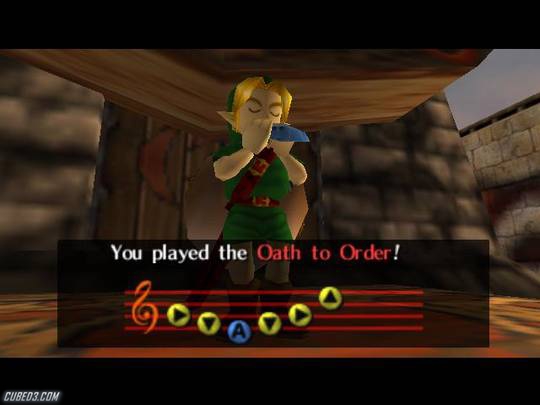The Legend of Zelda: Majora's Mask (Nintendo 64) Review
By Ross Morley  05.06.2003
05.06.2003

"Isn't it nice when things just... work?" That was the slogan that went along with Honda's latest advert promoting their new Accord. It's strange then that this phrase also goes so well for gaming. To create a perfect, or near perfect title the game has to have it all. What this is depends on the type of game you're developing, but to make the game stand out it's got to have something that other games can never match, and when it all comes together it has to just... work.
The year is 1998 and the gaming community has just been taken by storm by The Legend Of Zelda: Ocarina Of Time. For the majority, this game represented perfection in its purest, most elegant form; few found the words to be able to fault it. It's a tribute to its brilliance and superiority that many still proudly regard it as the best videogame ever, the finest of compliments any games developer could ever hope to receive.
Two years later and the eagerly awaited Majora's Mask arrived, sequel to Ocarina Of Time. We can only imagine the sort of pressure Nintendo were under to create another enthralling Zelda experience after the success of the first N64 title, so did they achieve their goal? But did they really hope to beat Ocarina Of Time, or were they aiming to make a game that would take the ingredients of the prequel to make something equally stunning?
When you turned on your console with the Ocarina Of Time cartridge in, you got a beautiful scene of Link travelling across Hyrule Field on horseback. Besides being picturesque, it was also one of the most moving scenes in the whole game. The music, the visuals and the idea and serenity of it all took control of you. Majora's Mask's equivalent scene gives you some idea as to what the story is about. You are shown the lovely, cosy little area that is Clock Town, and typically wondrous music plays. It's all very moving but one point in the sequence makes you realize why the game will hold you. Near the end of it you are shown the clock tower as the camera moves up the side of it. Slowly the cheerful music dies away and darker tones kick in. Then, on top of the tower you get your first glimpse of the enemy.

Clock Town is in the centre of the land of Termina and acts as the game's hub area. Here you'll find all the hustle and bustle of everyday life in shops, inns, houses and various other buildings. It's quite a large area and it's crammed full of things for you to do. The tasks you get up to are ones that can only be found in a Zelda game. Addictive mini games, errands, finding things and exploring will all be important in getting heart pieces and other rewards. There are 52 heart pieces in Majora's Mask, outnumbering Ocarina Of Time's 36. As you'd expect, they are spread across all the different lands that make up Termina, and the ways in which they can be won or found differ tremendously and are always fun and often challenging.
As is the norm in all adventure games, the terrain and climate alters dramatically as you move from one area to another. In fact, a feature of Termina Field is that four completely different regions surround it. There is a swamp to the south (home of the Deku Tribe), a freezing mountain range to the north (home of the rock munching Gorons), a sea world to the west (home of the Zoras) and a mysterious rocky, mountainous area to the east (wandering spirits inhabit this area). Close to the entrance of the swamp there lies Milk Road, which winds through to Romani Ranch, the equivalent of Lon Lon Ranch. The layout of Termina is simpler than that of Hyrule, but nonetheless beautiful. It is also smaller than Hyrule, but don't be fooled because there is SO much to see and do.

Zelda games are well known for their array of pleasant, awe inspiring tunes. Majora's Mask follows this trend with striking music throughout. It will always be a mystery how they make the sound in Zelda so damn good, and so fitting for every location, whether it be light or dark, bright or gloomy, happy or tense. The music in Clock Town in particular is so lovely, and adds to the splendour of its design and beauty. There are no dodgy tunes in Majora's Mask, every piece does its job to good effect. At night the music dies away, allowing you to hear the high-pitched tones of crickets concealed in the bushes, or the continuous banging of the worker's hammers in South Clock Town. It really is a wonder to listen to, whether you're watching or playing.
Inevitably the visuals in Majora's Mask have an advantage over those in Ocarina Of Time. Outlines are that much sharper, textures are a bit clearer and helped along by a slightly smoother frame rate. It has, however, stuck very much with the same style as its predecessor. The sky changes colour as time flows in the same tranquil way, and the look of everything in sight tries to cast a similar atmosphere as before. Even the characters have that Ocarina Of Time edge to them, many have even returned (the Gorons, Dekus and Zoras have all starred in both games). One special mention has to go to one point in the game though. As the time ambles past midnight on the final day, the reality of it all draws close. The moon has almost devoured the entire skyline, and in the air above that is still visible a sad red colour has filled the gap.

A good way to sum up this game would be to compare it to Ocarina Of Time, so that's exactly what we're going to do, looking at the four points games are marked on. First of all we have the graphics. As we know, Majora's Mask is superior as you'd expect from a newer game, but there isn't that much difference meaning it's still a fair contest. Ocarina Of Time was the first game to stun us with its brilliant use of lighting effects. As the sun set the shadows in the corners of the world would die, and we used to sit on Epona's back on the ridge of Hyrule Field just watching the sky change colour. Admittedly, Majora's Mask does this as well but we've always felt that the beauty of Termina could not match that of Hyrule, making effects such as this work better in the latter world. This goes for many of the areas. Design always helps to bring out the best in graphics, and we must say that we think the older game is the prettier of the two.
In terms of sound quality both shine like a bright star on a dark night, but Majora's Mask just can't stand up to its older brother in this department. When you listen to all the tunes from both games you notice that one is the clear winner. Ocarina Of Time always has a perfect tune to set the right mood in the right setting. Majora's Mask does this too but the music just isn't quite so perfect.
Majora's Mask has four dungeons (as we have already pointed out). Ocarina Of Time has nine main temples and yes, it is the bigger game physically and in truth. Majora's Mask has loads more heart pieces but ultimately is a smaller adventure. Don't get us wrong though, both are huge games just waiting to be explored by young Link (or possibly adult Link, if you're picky...) and both have tonnes of secrets to discover.

Cubed3 Rating
Exceptional - Gold Award

This truly is a title that Ocarina Of Time can be proud to call its sequel. Quality just seeps out of every area, shop, character, dungeon, and when you walk into a new area, the quality of the atmosphere hits you. A super adventure that has all the best elements of Ocarina Of Time and great touches everywhere you look.

![]() 6/10
6/10
![]() 9/10
(102 Votes)
9/10
(102 Votes)
 Out now
Out now  Out now
Out now  Out now
Out now  Out now
Out now Comments
Comments are currently disabled

 Sign In
Sign In Game Details
Game Details Subscribe to this topic
Subscribe to this topic Features
Features





 Top
Top

